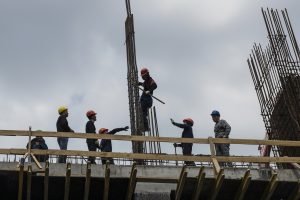Two developments illustrate a crisis gripping the Russian economy in no small part because of the drop in labor migrants despite high demand for additional labor.
On October 8, Russia’s Ministry of Internal Affairs announced that 150,000 citizens of Tajikistan and 150,000 citizens of Uzbekistan who had been subject to entry bans had been amnestied. Entry bans, many imposed for small infractions, overwhelmingly affect labor migrants from Central Asia. Earlier, on October 1, the Agency for External Labor Migration in Uzbekistan under the Ministry of Employment and Labor Relations announced the recruitment of 10,000 people for work on construction sites in Russia.
Russia has been aggressive in the last decade in creating punitive laws and regulations directed at labor migrants. An entry ban of three years was introduced in 2013 for foreign citizens after committing two or more administrative offenses within a three year period. Receiving such a ban is easy given the array of government agencies in Russia that can request it and the multitude of small infractions that count as administrative offenses, such as jaywalking, parking tickets, not carrying identification documents, and more. Police corruption and a biased judiciary, in addition, made appearing on the entry ban list just a matter of time for many.
Travel restrictions to enter Russia and exit Central Asian countries imposed as a result of the COVID-19 pandemic added another layer of challenges for Central Asian migrants, for whom Russia is a traditional destination for employment. Those challenges are now felt on the demand side as well as Russia’s economic sector is highly reliant on cheap Central Asian labor. The Russian government is now trying to be creative with undoing the restrictions.
Russia’s construction sector for years has been largely staffed by Central Asian migrants. Russia’s Deputy Prime Minister Marat Khusnullin said in July that construction sites in Russia were short of 1.5-2 million people and called the situation “a catastrophic shortage of workers.” According to an August analysis from Avito Rabota, Russia’s leading job advertisement board, over the past two years, the number of vacancies in construction increased by 104 percent; transport and logistics by 136 percent; and production by 127 percent.
Clearly, the 300,000 individuals whose entry bans have been lifted will not be able to satisfy the current demand in Russia’s labor market; therefore, other means of recruitment are also being pursued. Russia and Uzbekistan are piloting a program to recruit and send 10,000 construction workers, issuing them work permits (patents) before they depart Uzbekistan. Obtaining a work permit is a seven-step process required to be completed within 30 days of entry into Russia.
Under the new in-country legalization process, the Russian National Association of Builders (NOSTROY) in cooperation with the Ministry of Employment and Labor Relations of Uzbekistan will test potential migrants in Uzbekistan on their theoretical knowledge of the trade to confirm their qualifications. In addition, on October 8, a group of Russian medical workers arrived in Uzbekistan to certify the health of potential migrants heading for Russia to confirm they are free of drug addiction and infectious diseases. While the medical examination is a part of the seven-step process to obtain a work permit for migrants from non-Eurasian Economic Union (EAEU) member countries, which citizens of Uzbekistan and Tajikistan fall under, trade-related testing is a fully new certification process.
The process of obtaining work permits in the country of origin is being piloted with 10,000 Uzbek migrants first and could become a part of a regular process unless or until the country joins the EAEU. First Deputy Minister of Employment and Labor Relations of Uzbekistan Erkin Mukhitdinov talked about taking a long-term perspective, noting that this program took about four years to put together. It seems Tashkent isn’t necessarily in a hurry to join the EAEU, as its pursuit of alternatives to addressing the hurdles of migration illustrates.
Lifting entry bans for 300,000 citizens of the two largest suppliers of labor migrants and organizing a recruitment process providing necessary documentation before migrant departures suggests that construction companies in Russia have grown fully dependent on migrant labor. The construction sector has the highest demand for labor migration, and following pandemic restrictions their Central Asian workers were not replaced by either domestic workers or workers from other countries.

































